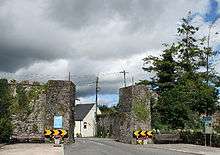Jamestown, County Leitrim

Jamestown (Irish: Cill Srianáin)[1] is a village on the banks of the River Shannon in County Leitrim, Ireland. It lies some 5 km east-south-east of the county town, Carrick-on-Shannon.
Jamestown was built as a walled plantation town for seventeenth-century English settlers alongside the earlier settlement of Cill Srianáin, which included an Abbey. It used to be on the main Sligo to Dublin road (N4) and was known for the narrow pillars of the arch of the old town gate that straddles the road in the centre of the village. The arch was damaged by a passing lorry in the early 1970s and the top was removed. In recent years at Christmas a lighted skeletal arch has been erected by the local community.
Two pubs and a church mark the centre of the village, close to remains of the boundary walls. Jamestown lies beside the Shannon with its own jetty and is a popular stopping point for boats. Navigation for cruisers is not possible downstream of Jamestown, boats are required to use the Jamestown Canal and Albert Lock (River Shannon) which links to the Shannon south of Drumsna
History
The settlement was created by Royal Charter of James I in 1621, and was founded in 1622 as a plantation town carrying into action the decision of 1620 to plant Leitrim with loyal English settlers. It was granted to Sir Charles Coote, a Devonshire Planter, who fortified it with walls[2] twenty feet high and six feet in thickness, enclosing an area of about 4 acres (16,000 m2) which contained a castle. It had an area of 200 acres (0.81 km2) under its liberty. The Borough with a very restricted franchise returned two members to the Irish Parliament until the Act of Union with Britain in 1801. Among its parliamentary representatives were Sir Charles Coote (1634–1660), John Fitzgibbon, 1st Earl of Clare, (1776) and Richard Martin, "Humanity Dick". The surnames Butler and Clyne are particularly numerous in the Jamestown area.
A Stone cross over a small gate (constructed by Murtagh O'Dowd, local blacksmith), outside the old town gate, leads to the remains of a Franciscan friary of the convent of the Friars' Minor. The Franciscan convent of the Friars Minor was not founded until the occupation of Jamestown in 1642 by the O'Rourkes.
A synod held here in 1650 repudiated the Duke of Ormond, Lord Lieutenant of Ireland and excommunicated his followers.
River crossings
Both Jamestown and Drumsna have long been important fording places across the Shannon. The present stone bridges were built during the 19th century as part of improvements to the Shannon navigation. The main Dublin - Sligo road ran across these until a bypass was completed in the late 1990s.
Doon of Drumsna
The Dún (Doon) of Drumsna, an Iron Age fortification built to protect Connacht from invaders from the north, lies opposite the jetty and runs across the Shannon peninsula between Jamestown and Drumsna. It was one of many linear earthworks built across the country around that time. The main rampart was massive with parts still standing up to 6 metres high and 30 metres across at the base. Additional banks were built on either side of the main rampart which extends for 1.6 kilometres. Two main entrances were built as pincer or Zangentor defensive works.
In addition to the main rampart, a secondary rampart extends upstream along the western river bank where shallows existed.[3]
See also
References
- ↑ http://www.logainm.ie/29165.aspx
- ↑ http://www.buildingsofireland.ie/niah/search.jsp?type=record&county=LE®no=30814006
- ↑ "The doon of Drumsna" Archaeology Ireland
Coordinates: 53°55′37″N 8°01′46″W / 53.92694°N 8.02944°W